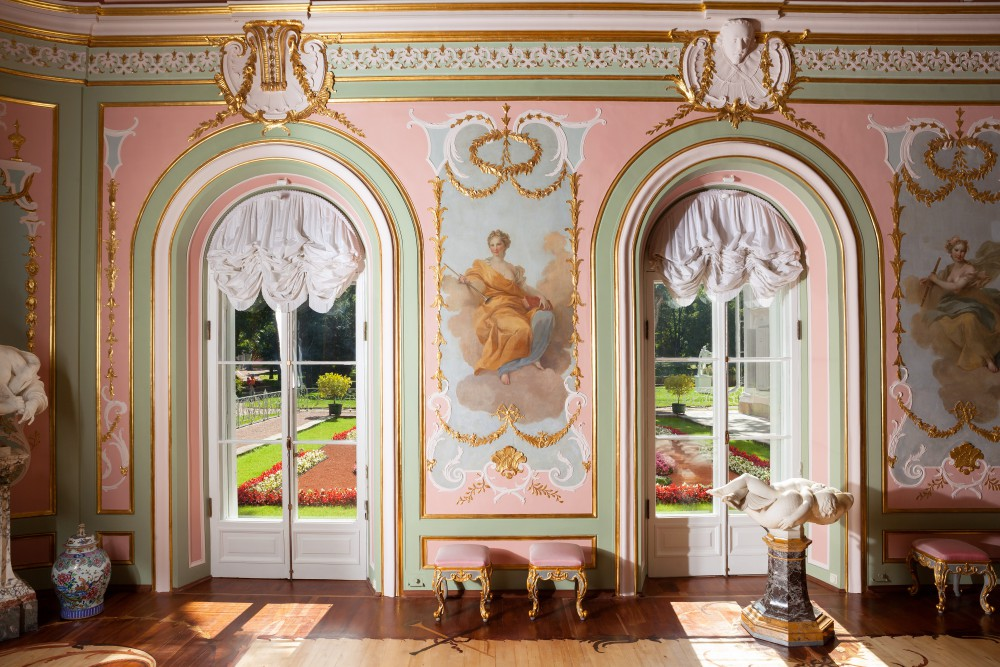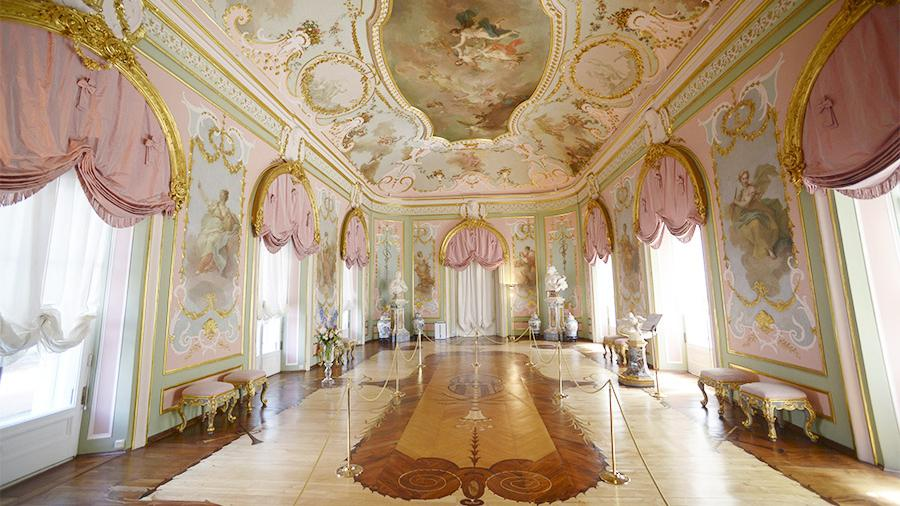Note! / Внимание!
[EN]: Oranienbaum is the name of a park. This geocache is about Chinese Palace in the park. But the cache is located outside of the park - in the forest area near the parking.
[RU]: Ораниенбаум - это название большого парка. Данный тайник посвящен Китайскому дворцу, расположенному на территории парка. Но сам тайник находится за пределами парками - на лесном участке возле парковки парка.
[EN]

Geocache Instructions:
- The cache is located near the parking area at the southern park entrance.
- Walk past the picnic area (on the right) along the small bridge (wooden logs) into the forest.
- The cache will be located on the left of the path.
Visiting tips:
- Park & Museum working hours: 09:00 - 19:00
- Tickets for the park and palace can be purchased at the box office near the parking. You can also purchase tickets at the Museum’s website: https://tickets.peterhofmuseum.ru/en/#id=121
- Cache is located near the free and paid parking where you can left your car before visiting.
- In summer, a mini-zoo works near the Chinese Palace, where you can see various birds and animals.
History of Oranienbaum’s Chinese Palace
Oranienbaum is a Russian royal residence, built in the XVIII century and located on the Gulf of Finland 40 km west to St. Petersburg. The Palace ensemble and the town centre are included in UNESCO World Heritage Sites.
According to one version, the historical name of Oranienbaum means “orange tree”, because founder of the manor and park Prince Alexander Menshikov grew oranges in the greenhouses of the palace. According to another version — the name is dedicated to William III of Orange, king of England, who was very revered by a close friend of Menshikov, Russian emperor Peter the Great. One way or another, an orange tree still adorns the coat of arms of this northern town.
 Chinese Palace — is a real rokoko gem of Oranienbaum Park. It was built by the architect Antonio Rinaldi in 1762-1768 for the great empress Catherine II. It got its name, because of the interiors that are decorated in the chinese aesthetics style “Chinoiserie”, which was very fashionable at that time. The palace is unique not only for its exquisite exotic, but also because its interiors have been preserved in absolute authenticity.
Chinese Palace — is a real rokoko gem of Oranienbaum Park. It was built by the architect Antonio Rinaldi in 1762-1768 for the great empress Catherine II. It got its name, because of the interiors that are decorated in the chinese aesthetics style “Chinoiserie”, which was very fashionable at that time. The palace is unique not only for its exquisite exotic, but also because its interiors have been preserved in absolute authenticity.
Catherine II called her Chinese palace a "jewelry box." Despite its modest appearance, the palace impresses with the brilliance and beauty of its interiors. Stylized oriental motives of decoration and many genuine works of Chinese and Japanese art give special refinement to the Rococo interiors. Glass Cabinet, Shtofnaya Bedchamber, Hall of Muses, Blue and Pink Salons — the very names of the halls of the palace carry the bright spirit of the Rococo era.
The Chinese palace was conceived not as a residence, but as a summer resting place for the young princess and her maid of honor. Catherine II made the first sketches of Chinese summer cottage and it’s surroundings by herself. She managed to realize her bold plan after she ascended the throne and became the sovereign empress. The Chinese palace has become an important part of Russian political life — here the empress often received ambassadors and noble guests from around the world.
 In total, the Chinese Palace has 17 magnificent halls. They were dedicated for arranging balls and fests, playing board games and relaxation. Moreover, the interior of each of the halls is unique and different from all the others.The refined parquet of the Chinese Palace is unique not only for its complex design, but also because more than 20 species of rare trees were used to create it.
In total, the Chinese Palace has 17 magnificent halls. They were dedicated for arranging balls and fests, playing board games and relaxation. Moreover, the interior of each of the halls is unique and different from all the others.The refined parquet of the Chinese Palace is unique not only for its complex design, but also because more than 20 species of rare trees were used to create it.
The most famous hall of the Chinese palace is the Glass Cabinet. The walls of the room are decorated with twelve glassy panels. These are canvases on which fantastic paintings in oriental style are embroidered with glass beads. Glass beads were made at a mosaic factory founded near Oranienbaum. Complicated compositions with images of fantastic birds amaze with their breathtaking atmosphere.

[RU]

Инструкции по поиску тайника:
- Тайник расположен рядом с автомобильной парковкой у южного входа в парк.
- Пройдите мимо места для пикника (справа) по импровизированному мостику из брёвен в лес.
- Тайник будет расположен слева от тропинки.
Советы перед посещением:
- Режим работы парка с 9:00 до 19:00
- Билеты в парк и дворец можно приобрести в кассах музея, которые находятся рядом с парковкой. Также билеты можно приобрести на сайте музея заповедника: https://tickets.peterhofmuseum.ru/ru/#id=121
- Рядом с тайником находится платная и бесплатная автомобильная парковка. Здесь Вы можете оставить свой автомобиль перед посещением парка.
- В летнее время рядом с Китайским дворцом работает зверинец, где вы можете увидеть различных птиц и животных.
История Китайского Дворца в Ораниенбауме
Ораниенбаум — это дворцово-парковый ансамбль XVIII века и императорская резиденция, расположенная на южном берегу Финского залива в 40 км от Санкт-Петербурга.
По одной из версий, историческое название города Ораниенбаум означает «апельсиновое дерево», поскольку основатель поместья и парка, князь Александр Меньшиков выращивал апельсины в теплицах дворца. По другой версии — имя посвящено Вильяму III Оранскому, королю Англии, которого очень уважал близкий друг Меншикова, русский император Петр Великий. Так или иначе, апельсиновое дерево до сих пор украшает герб этого северного города.

Китайский Дворец — является настоящей жемчужиной рококо Ораниенбаумского парка. Он был построен по проекту архитектора Антонио Ринальди в 1762—1768 гг. для императрицы Екатерины II. Своё название получил благодаря тому, что его интерьеры отделаны в китайском стиле “шинуазри”, который в то время был очень модным. Дворец уникален не только своей изысканной экзотичностью, но и тем, что его интерьеры сохранились до наших дней в абсолютной подлинности.
Екатерина II называла Китайский дворец своей «шкатулкой с драгоценностями». Несмотря на свой скромный внешний облик, дворец поражает блистательной красотой своих интерьеров. Особую утонченность интерьерам придают стилизованные восточные мотивы декоративного убранства и множество подлинных произведений искусства Китая и Японии. Стеклярусный кабинет, Штофная Опочивальня, Зал Муз, Голубая и Розовая гостиные — сами названия залов дворца несут в себе яркий дух эпохи рококо.
 Китайский дворец задумывался не как резиденция, а как летнее место отдыха юной принцессы и её фрейлин. Первые наброски дворца и его парков были выполнены лично Екатериной II. Реализовать свой смелый замысел ей удалось после того, как она взошла на трон и стала властительной императрицей. Китайский дворец стал важной частью политической жизни России — здесь императрица часто принимала послов и знатных гостей со всего мира.
Китайский дворец задумывался не как резиденция, а как летнее место отдыха юной принцессы и её фрейлин. Первые наброски дворца и его парков были выполнены лично Екатериной II. Реализовать свой смелый замысел ей удалось после того, как она взошла на трон и стала властительной императрицей. Китайский дворец стал важной частью политической жизни России — здесь императрица часто принимала послов и знатных гостей со всего мира.
Всего в Китайском дворце 17 великолепных залов. В них проводили балы, играли в карты, отдыхали и устраивали застолья. Причем, интерьер каждого из залов уникален и отличается от всех остальных. Изысканный паркет Китайского дворца уникален не только своим сложным рисунком, но и тем, что для его создания было использовано более 20 пород редких деревьев.
Самым знаменитым покоем Китайского дворца является Стеклярусный кабинет. Стены комнаты декорированы двенадцатью стеклярусными панно. Это холсты, на которых сделана вышивка стеклярусом, изготовленном на мозаичной фабрике, основанной в окрестностях Ораниенбаума русским учёным М. В. Ломоносовым. На фоне стекляруса шелком вышиты сложные композиции с изображениями фантастических птиц, которые поражают своей искусной работой.
